Study on Material Removal Mechanism of Non-Resonant Vibration-Assisted Scratching High-Volume Fraction SiCp/Al
Abstract
1. Introduction
2. Materials and Methods
2.1. Setup of the Scratching Experiment
2.2. Modeling Details for MD Simulation
3. Results and Discussion
3.1. Implication of Vibration Frequency on Scratching Outcomes
3.1.1. Surface Morphology Analysis
3.1.2. Scratching Force Analysis in CS and NVAS Processes
3.2. MD Simulation of the Repercussion of Vibration Frequency on Scratching Results
3.2.1. Repercussion of Vibration Frequency on the Cross-Section of Scratched Grooves
3.2.2. Hydrostatic Stress, Dislocation, and Phase Transition Analysis
3.2.3. Effect of Vibration Frequency on Scratching Force
4. Conclusions
- (1)
- The increase in vibration frequency changes the material removal behavior. At 30 Hz, particle crushing intensifies and the plasticity removal area decreases. At 60 Hz, particle crushing worsens, but at 120 Hz, particle crushing is reduced, the plasticity removal area increases, and the scratching groove becomes smoother.
- (2)
- Simulations show that frequencies of 12.5 GHz and 50 GHz significantly increase HCP structures and dislocation density compared to CS. A 100 GHz vibration frequency leads to more uniform SiC particle removal, improved smoothness of the scratching contour, wider hydrostatic stress distribution, more uniform dislocation distribution, and a reduction in dislocation loops and HCP structures. The phenomenon of dislocation plugging is improved considerably, and the density of dislocations is reduced, which contributes to plastic deformation.
- (3)
- Higher vibration frequency reduces the scratching force. Compared to the CS, as the vibration frequency increases by 120 Hz, the average normal scratching force drops from 0.069 N to 0.0628 N, and the average axial scratching force decreases from 0.012 N to 0.006 N. According to the simulation results, the average axial scratching force is 1.86 nN, and the instantaneous axial scratching force can reach a maximum of 97 nN when the vibration frequency increases by 100 GHz.
Author Contributions
Funding
Data Availability Statement
Conflicts of Interest
Abbreviations
| SiCp/Al | aluminum-based silicon carbide |
| CS | conventional scratching |
| NVAS | non-resonant vibration-assisted scratching |
| MD | molecular dynamics |
| PZT | piezoceramic |
References
- Fan, Y.; Xu, Y.; Hao, Z.; Lin, J. Dynamic behavior description and three-dimensional cutting simulation of SiCp/Al composites with high volume fraction. J. Manuf. Process. 2022, 77, 174–189. [Google Scholar] [CrossRef]
- Wang, J.; Gao, Q.; Lu, J.; Zheng, Q.; Xi, X.; Zhang, Y.; Zhao, W. Fast ED-milling of high volume fraction Al/SiCp metal matrix composites. CIRP Ann. 2024, 73, 121–124. [Google Scholar] [CrossRef]
- Yu, X.; Huang, S.; Xu, L. ELID grinding characteristics of SiCp/Al composite. Int. J. Adv. Manuf. Technol. 2016, 86, 1165–1171. [Google Scholar] [CrossRef]
- Liu, D.; Li, C.; Xu, P.; Wang, W.; Zhang, Y.; Yang, M.; Cui, X.; Li, B.; Liu, M.; Gao, T.; et al. SiCp/Al composites from conventional to empowered machining: Mechanisms and processability. Compos. Struct. 2024, 346, 118433. [Google Scholar] [CrossRef]
- Cao, J.; Wu, Y.; Lu, D.; Fujimoto, M.; Nomura, M. Material removal behavior in ultrasonic-assisted scratching of SiC ceramics with a single diamond tool. Int. J. Mach. Tools Manuf. 2014, 79, 49–61. [Google Scholar] [CrossRef]
- Cao, S.; Zhang, X.; Wu, C.; Yang, M.; Xia, K. Towards understanding the material removal mechanism on the effect of ultrasonic vibration and anisotropy for unidirectional CFRP by scratching. J. Mater. Process. Technol. 2024, 324, 118250. [Google Scholar] [CrossRef]
- Zhang, M.; Shan, C.; Xia, Z.; Luo, M.; Zhang, D. Scratch-induced surface formation mechanism in C/SiC composites. Int. J. Mech. Sci. 2024, 265, 108885. [Google Scholar] [CrossRef]
- Gu, Y.; Li, Z.; Lin, J.; Zhou, X.; Xu, Z.; Zhou, W.; Zhang, S.; Gao, Y. Enhanced machinability of aluminium-based silicon carbide by non-resonant vibration-assisted magnetorheological finishing. J. Mater. Process. Technol. 2023, 324, 118223. [Google Scholar] [CrossRef]
- Zhao, X.; Gong, Y.; Cai, M.; Han, B. Comparative multiscale investigations of material removal behaviors of SiCp/5083Al, SiC ceramic and 5083Al alloy by single scratch tests. Mater. Res. Express 2020, 7, 106514. [Google Scholar] [CrossRef]
- Zhao, J.; Xu, X.; Li, W.; Hang, W. Material removal modes and processing mechanism in microultrasonic machining of ball ceramic tool. Ceram. Int. 2024, 50, 28844–28856. [Google Scholar] [CrossRef]
- Yang, Z.; Zhu, L.; Zhang, G.; Ni, C.; Lin, B. Review of ultrasonic vibration-assisted machining in advanced materials. Int. J. Mach Tools Manuf. 2020, 156, 103594. [Google Scholar] [CrossRef]
- Zheng, W.; Wang, Y.; Zhou, M.; Wang, Q.; Ling, L. Material deformation and removal mechanism of SiCp/Al composites in ultrasonic vibration assisted scratch test. Ceram. Int. 2018, 44, 15133–15144. [Google Scholar] [CrossRef]
- Zha, H.; Feng, P.; Zhang, J.; Yu, D.; Wu, Z. Material removal mechanism in rotary ultrasonic machining of high volume fraction SiCp/Al composites. Int. J. Adv. Manuf. Technol. 2018, 97, 2099–2109. [Google Scholar] [CrossRef]
- Xiang, D.; Liu, G.; Peng, P.; Zhang, Z. Micro-removal characteristics of SiCp/Al by ultrasonic vibration-assisted scratch. Mater. Manuf. Process. 2022, 37, 1829–1836. [Google Scholar] [CrossRef]
- Gu, Y.; Fu, B.; Lin, J.; Chen, X.; Zhou, W.; Yu, B.; Zhao, H.; Li, Z.; Xu, Z. A novel wheel-type vibration-magnetorheological compound finishing method. Int. J. Adv. Manuf. Technol. 2023, 125, 4213–4235. [Google Scholar] [CrossRef]
- Prabhu, P.; Rao, M. Investigations on piezo actuator-based non-resonant type workpiece vibratory system for vibration-assisted micro-milling. Int. J. Adv. Manuf. Technol. 2024, 134, 3397–3416. [Google Scholar] [CrossRef]
- Huang, W.; Tang, J.; Zhou, W.; Shao, W.; Yi, M.; Zhao, X.; Wen, J. Revealing nanoscale material deformation mechanism and surface/subsurface characteristics in vibration-assisted nano-grinding of single-crystal iron. Appl. Surf. Sci. 2022, 597, 153692. [Google Scholar] [CrossRef]
- Qiu-yang, Z.; Zhen-yu, Z.; Cong, D.; Yu, L.; En, L.; Sen-bin, Y.; Zhong-yu, P. Mechanical response of single-crystal copper under vibration excitation based on molecular dynamics simulation. J. Manuf. Process. 2022, 75, 605–616. [Google Scholar] [CrossRef]
- Qiu-Yang, Z.; Zhen-Yu, Z.; Yu, L.; Jianhao, C.; Sen-Bin, Y.; Zhong-Yu, P. Molecular dynamic simulation of the influence of vibration effects on scratching processes in Varied crystal orientations. Model. Simul. Mater. Sci. Eng. 2023, 31, 085017. [Google Scholar] [CrossRef]
- Ban, X.; Zhu, J.; Sun, G.; Han, S.; Duan, T.; Wang, N. Molecular simulation of ultrasonic assisted diamond grit scratching 4H-SiC single-crystal. Tribol. Int. 2024, 192, 109330. [Google Scholar] [CrossRef]
- Huang, W.; Tang, J.; Zhou, W.; Shao, W.; Wen, J.; Li, Z. Insight into the effect of vibration parameters on deformation mechanism during scratching of nanograin iron alloy by molecular dynamics. Tribol. Int. 2025, 201, 110190. [Google Scholar] [CrossRef]
- Yin, G.; Wang, D.; Cheng, J. Experimental investigation on micro-grinding of SiCp/Al metal matrix composites. Int. J. Adv. Manuf. Technol. 2019, 102, 3503–3517. [Google Scholar] [CrossRef]
- Zhu, C.; Gu, P.; Liu, D.; Hu, X.; Wu, Y. Evaluation of surface topography of SiCp/Al composite in grinding. Int. J. Adv. Manuf. Technol. 2019, 102, 2807–2821. [Google Scholar] [CrossRef]
- Zong, W.; Huang, Y.; Zhang, Y.; Sun, T. Conservation law of surface roughness in single point diamond turning. Int. J. Mach. Tool Manuf. 2014, 84, 58–63. [Google Scholar] [CrossRef]
- Yuan, Z.; Xiang, D.; Peng, P.; Li, Y.; Zhang, Z.; Li, B.; Su, B.; Gao, G.; Zhao, B. Analysis of microscopic deformation mechanism of SiCp/Al composites induced by ultrasonic vibration nanoindentation. J. Clean. Prod. 2024, 434, 140073. [Google Scholar] [CrossRef]
- Zhu, B.; Zhao, H.; Zhao, D.; Zhang, P.; Yang, Y.; Han, L.; Kui, H. Effects of vibration frequency on vibration-assisted nano-scratch process of mono-crystalline copper via molecular dynamics simulation. AIP Adv. 2016, 6, 35015. [Google Scholar] [CrossRef]
- Lin, Z.C.; Huang, J.C. The influence of different cutting speeds on the cutting force and strain-stress behaviors of single crystal copper during nano-scale orthogonal cutting. J. Mater. Process. Tech. 2008, 201, 477–482. [Google Scholar] [CrossRef]
- Doan, D.-Q.; Fang, T.-H. Effect of vibration parameters on the material removal characteristics of high-entropy alloy in scratching. Int. J. Mech. Sci. 2022, 232, 107597. [Google Scholar] [CrossRef]
- Chen, J.; Zhang, W.; Tong, K. Effect of twins on scratching behavior of nanotwinned diamond: A molecular dynamics simulation. Appl. Surf. Sci. 2023, 616, 156545. [Google Scholar] [CrossRef]
- Lin, J.; Fu, B.; Gu, Y.; Xi, Y.; Fu, L.; Wu, S.; Kang, M.; Liang, G. Experimental and MD simulation study of surface residual stress and surface quality of SiCp/Al in pulsed laser-ultrasonic assisted grinding. J. Mater. Res. Technol. 2024, 30, 7741–7755. [Google Scholar] [CrossRef]
- Vashishta, P.; Kalia, R.K.; Nakano, A.; Rino, J.P. Interaction potential for silicon carbide: A molecular dynamics study of elastic constants and vibrational density of states for crystalline and amorphous silicon carbide. J. Appl. Phys. 2007, 101, 103515. [Google Scholar] [CrossRef]
- Pascuet, M.; Fernández, J. Atomic interaction of the MEAM type for the study of intermetallics in the Al–U alloy. J. Nucl. Mater. 2015, 467, 229–239. [Google Scholar] [CrossRef]
- Thompson, A.P.; Aktulga, H.M.; Berger, R.; Bolintineanu, D.S.; Brown, W.M.; Crozier, P.S.; in’Veld, P.J.; Kohlmeyer, A.; Moore, S.G.; Nguyen, T.D.; et al. LAMMPS—A flexible simulation tool for particle-based materials modeling at the atomic, meso and continuum scales. Comput. Phys. Commun. 2022, 271, 108171. [Google Scholar] [CrossRef]
- Hirel, P. Atomsk: A tool for manipulating and converting atomic data files. Comput. Phys. Commun. 2015, 197, 212–219. [Google Scholar] [CrossRef]
- Stukowski, A. Visualization and analysis of atomistic simulation data with OVITO–the Open Visualization Tool. Model. Simul. Mater. Sci. Eng. 2009, 18, 015012. [Google Scholar] [CrossRef]
- Sun, G.; Shi, F.; Zhao, Q.; Ma, Z.; Yang, D. Material removal behavior in axial ultrasonic assisted scratching of Zerodur and ULE with a Vickers indenter. Ceram. Int. 2020, 46, 14613–14624. [Google Scholar] [CrossRef]
- Wang, Z.; Bao, Y.; Feng, K.; Li, B.; Dong, Z.; Kang, R.; Wang, Y. Characterization, quantitative evaluation and formation mechanism of surface damage in ultrasonic vibration assisted scratching of Cf/SiC composites. J. Eur. Ceram. Soc. 2024, 44, 4502–4523. [Google Scholar] [CrossRef]
- Liu, G.; Xiang, D.; Peng, P.; Li, Y.; Yuan, Z.; Zhang, Z.; Gao, G.; Zhao, B. Establishment of scratching force model for micro-removal of SiCp/Al composites by ultrasonic vibration. J. Mater. Process. Technol. 2022, 307, 117677. [Google Scholar] [CrossRef]
- Li, Z.; Yuan, S.; Ma, J.; Shen, J.; Batako, A.D. Study on the surface formation mechanism in scratching test with different ultrasonic vibration forms. J. Mater. Process. Technol. 2021, 294, 117108. [Google Scholar] [CrossRef]
- Wang, H.; Dong, Z.; Wang, C.; Kang, R.; Guo, X.; Bao, Y. Surface/subsurface formation mechanism of tungsten during ultrasonic elliptical vibration cutting. Int. J. Mech. Sci. 2024, 262, 108725. [Google Scholar] [CrossRef]
- Price, P.B. Pyramidal glide and the formation and climb of dislocation loops in nearly perfect zinc crystals. Philos. Mag. 1960, 5, 873–886. [Google Scholar] [CrossRef]
- Häussler, D.; Bartsch, M.; Messerschmidt, U.; Reppich, B. HVTEM in situ observations of dislocation motion in the oxide dispersion strengthened superalloy MA 754. Acta Mater. 2001, 49, 3647–3657. [Google Scholar] [CrossRef]
- Marshall, J.M.; Giraudel, M. The role of tungsten in the Co binder: Effects on WC grain size and hcp–fcc Co in the binder phase. Int. J. Refract. Met. Hard Mater. 2015, 49, 57–66. [Google Scholar] [CrossRef]
- Huang, C.; Yao, Y.; Peng, X.; Chen, S. Plastic deformation and strengthening mechanism of FCC/HCP nano-laminated dual-phase CoCrFeMnNi high entropy alloy. Nanotechnology 2021, 32, 505724. [Google Scholar] [CrossRef]
- Gunkelmann, N.; Alabd Alhafez, I.; Steinberger, D.; Urbassek, H.M.; Sandfeld, S. Nanoscratching of iron: A novel approach to characterize dislocation microstructures. Comput. Mater. Sci. 2017, 135, 181–188. [Google Scholar] [CrossRef]
- Wang, H.; Yang, G.; Su, H.; Dong, Z.; Guo, X.; Bao, Y.; Zhang, P. Insight into surface formation mechanism during ultrasonic elliptical vibration cutting of tungsten alloy by scratching experiment and molecular dynamics. Tribol. Int. 2024, 191, 109088. [Google Scholar] [CrossRef]
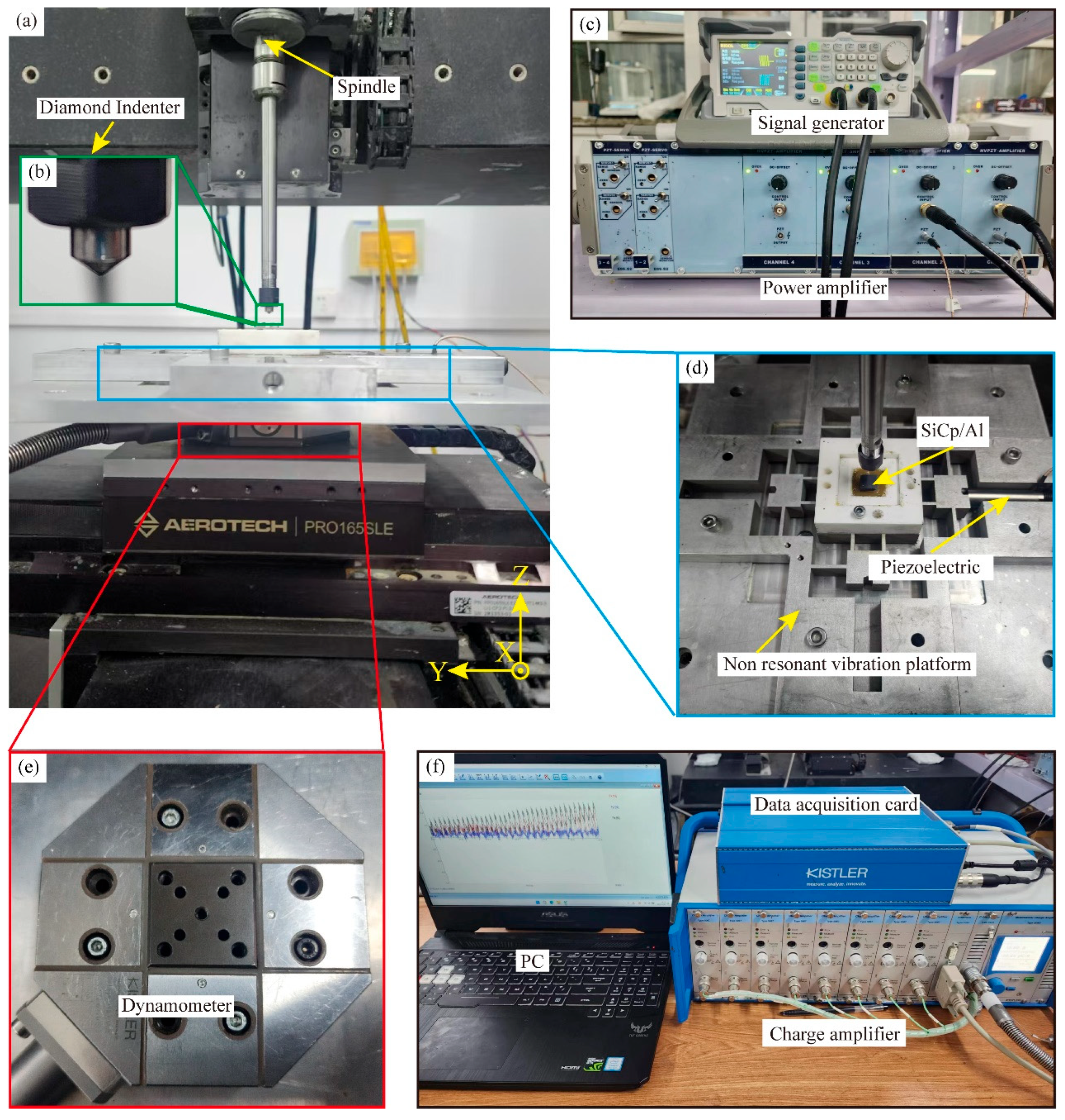
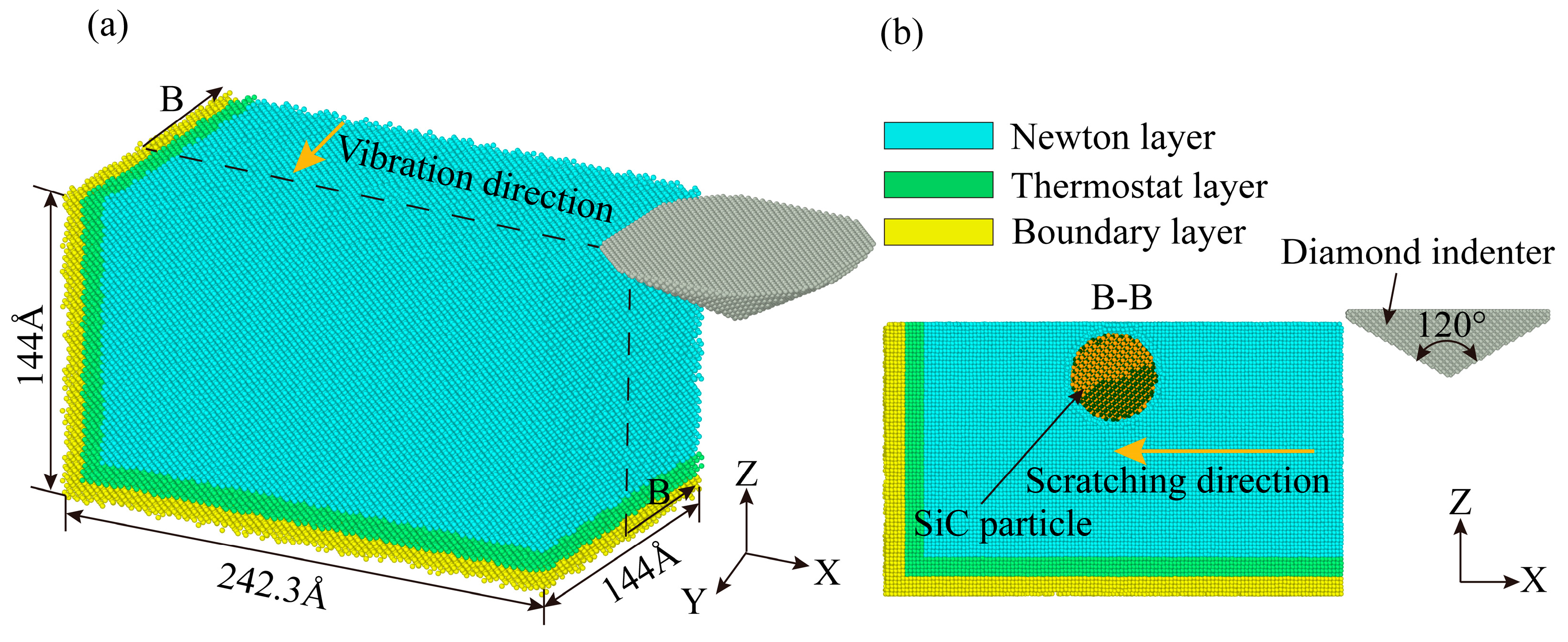
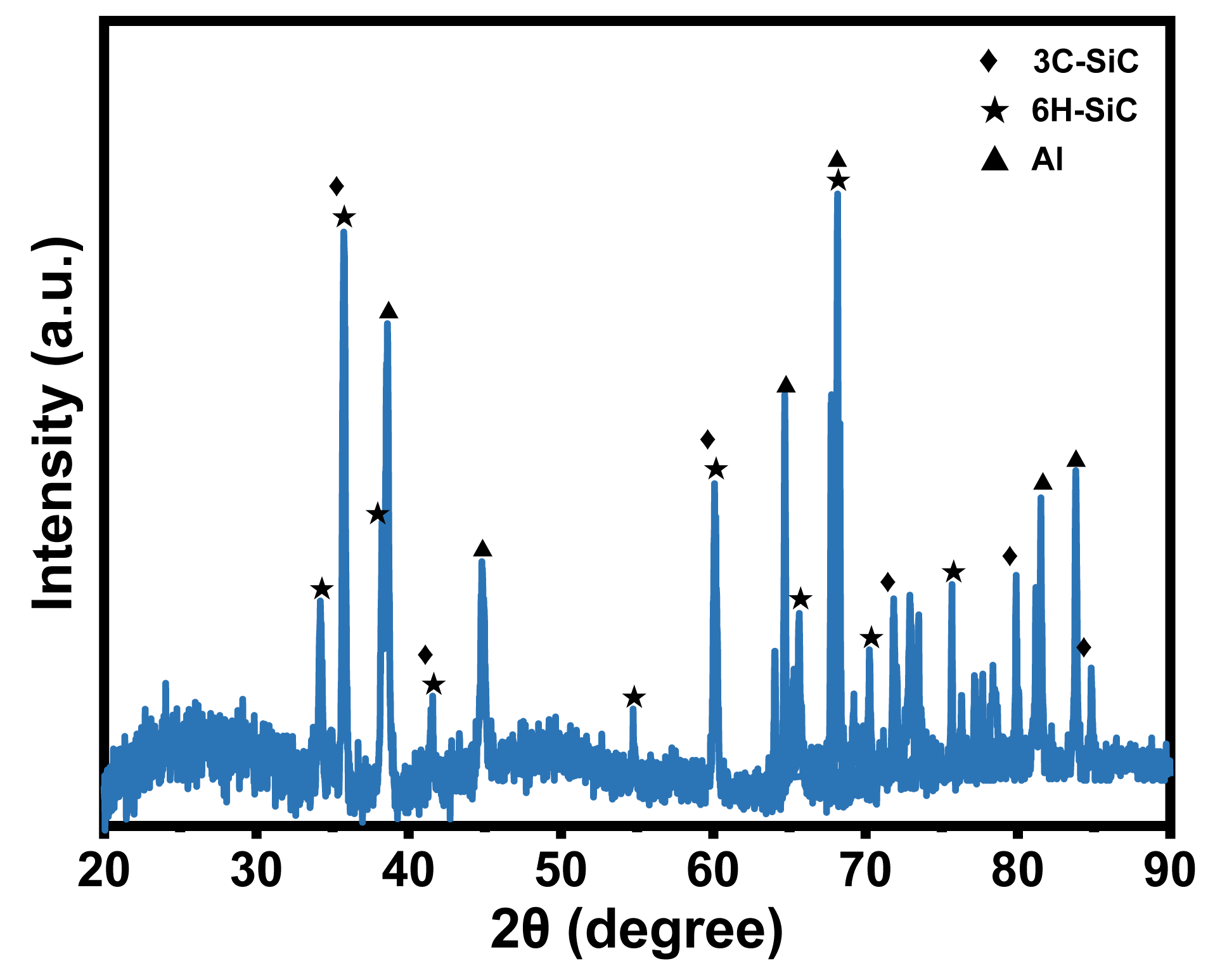
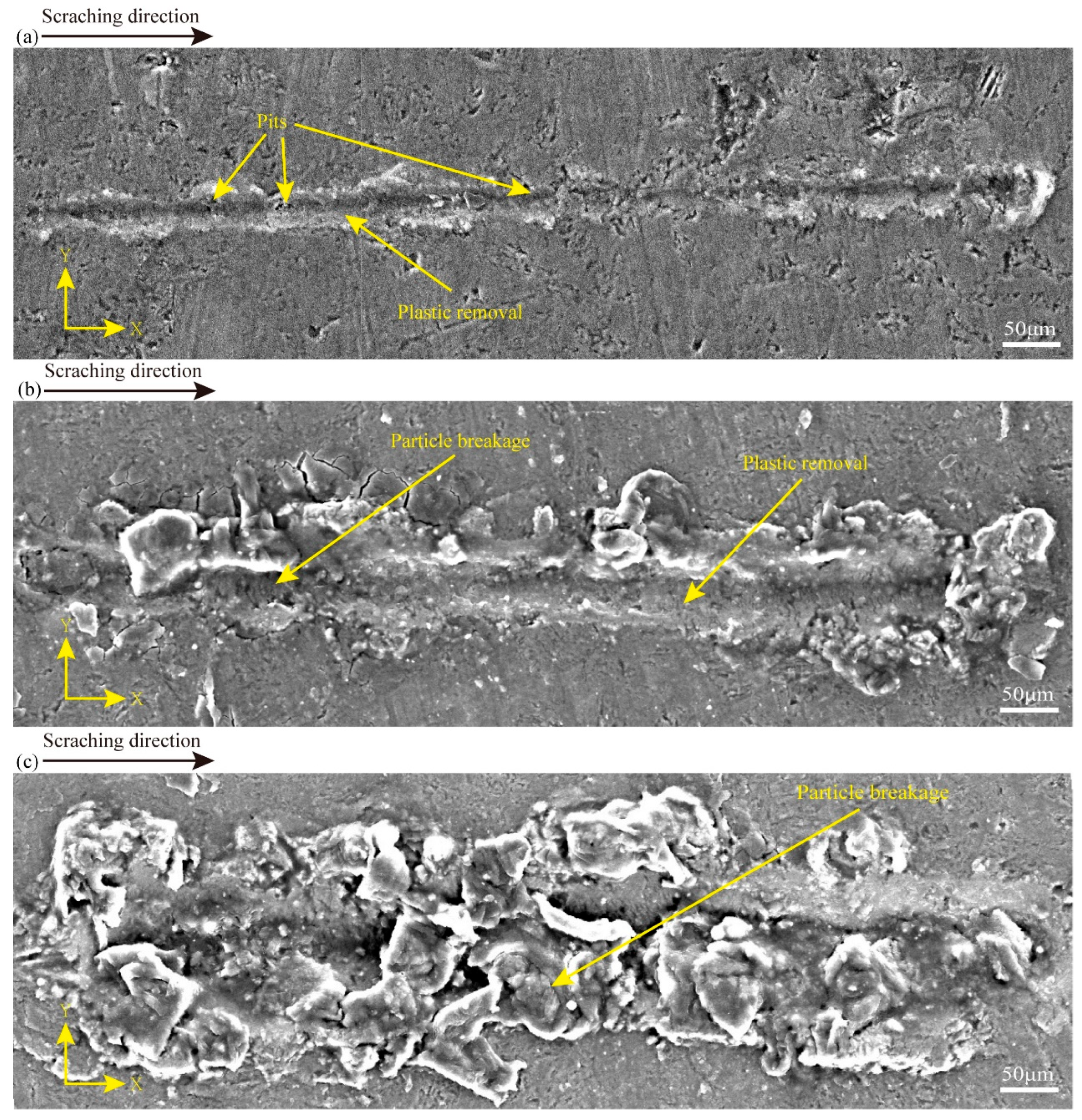
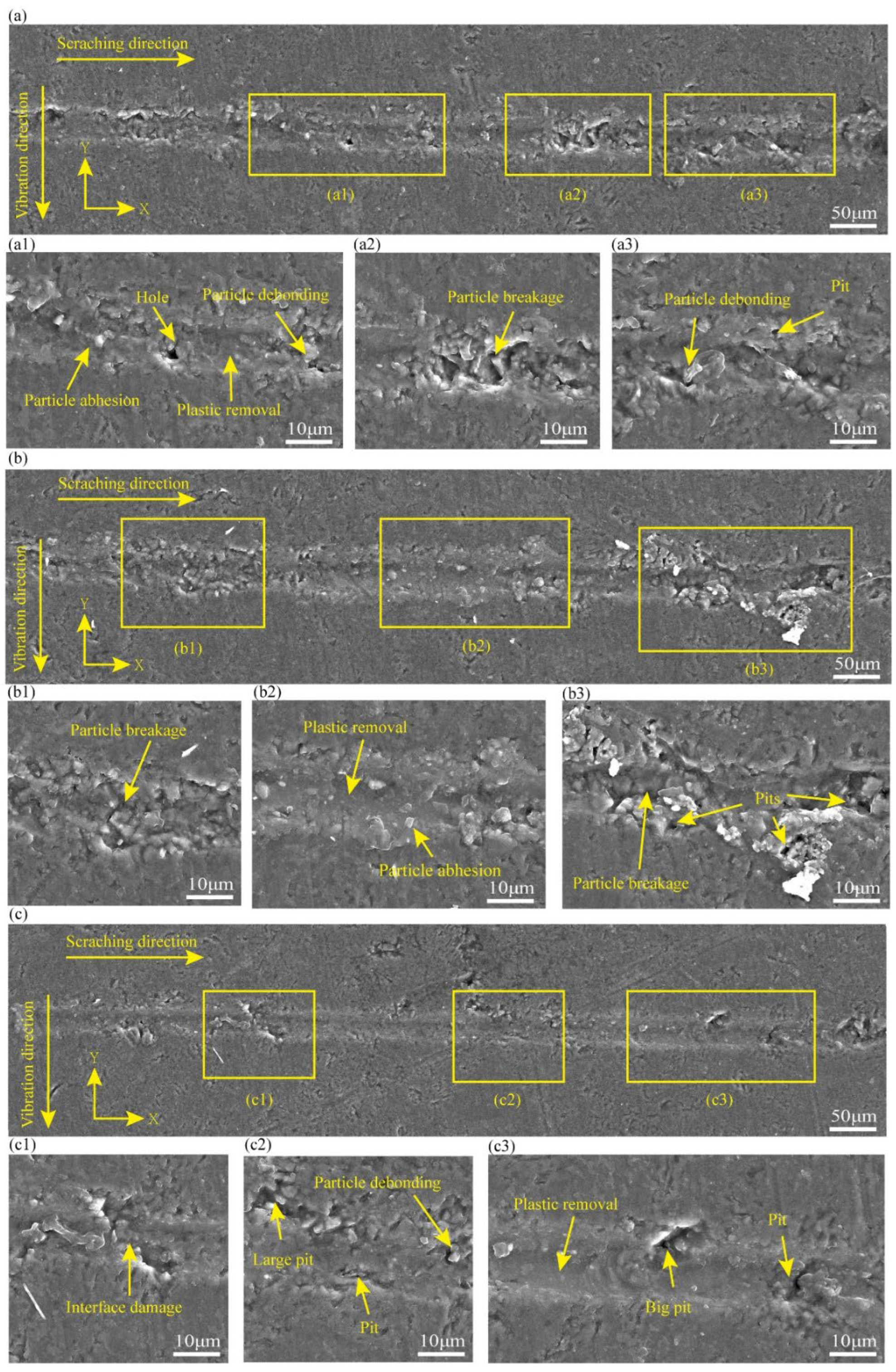
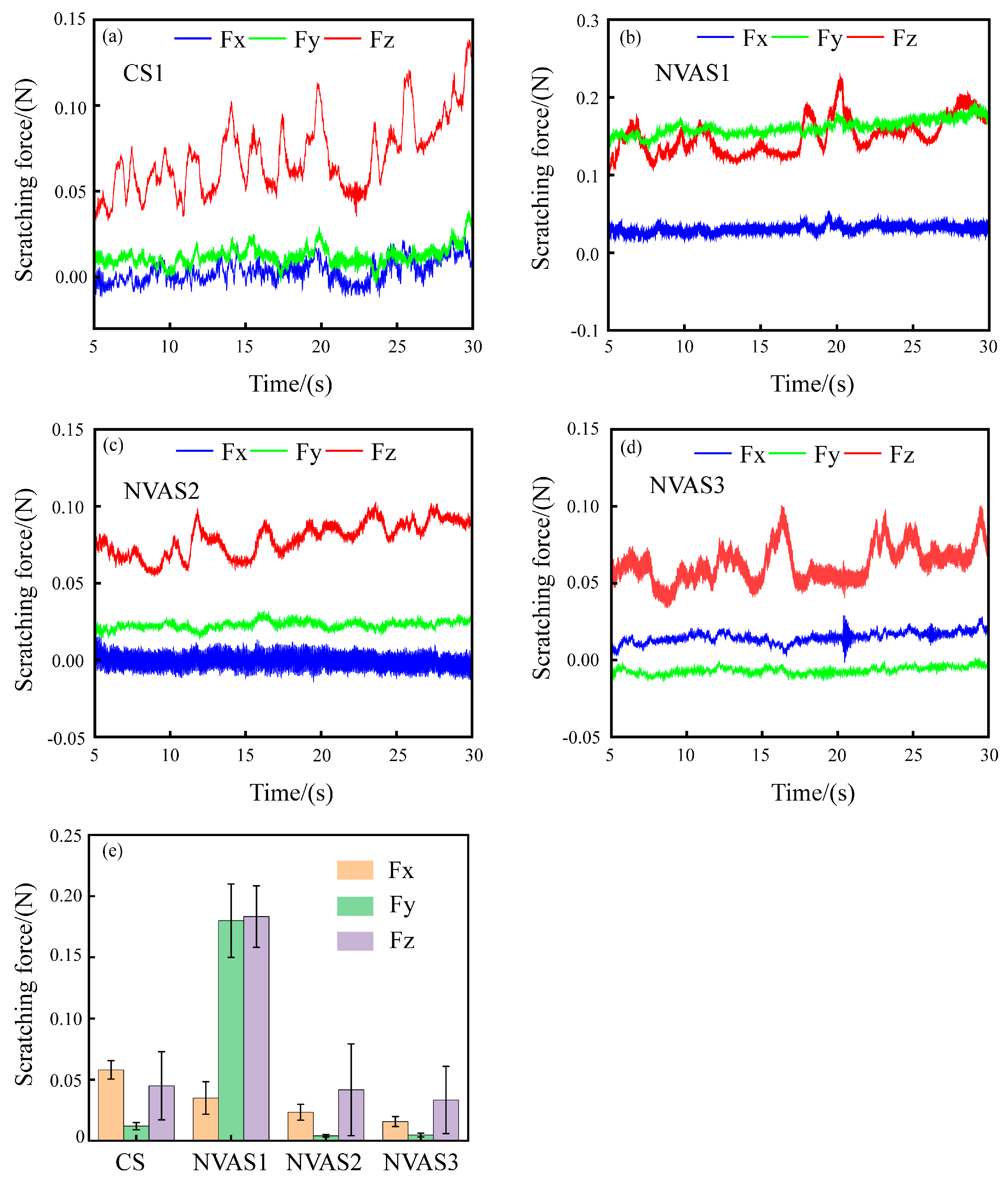
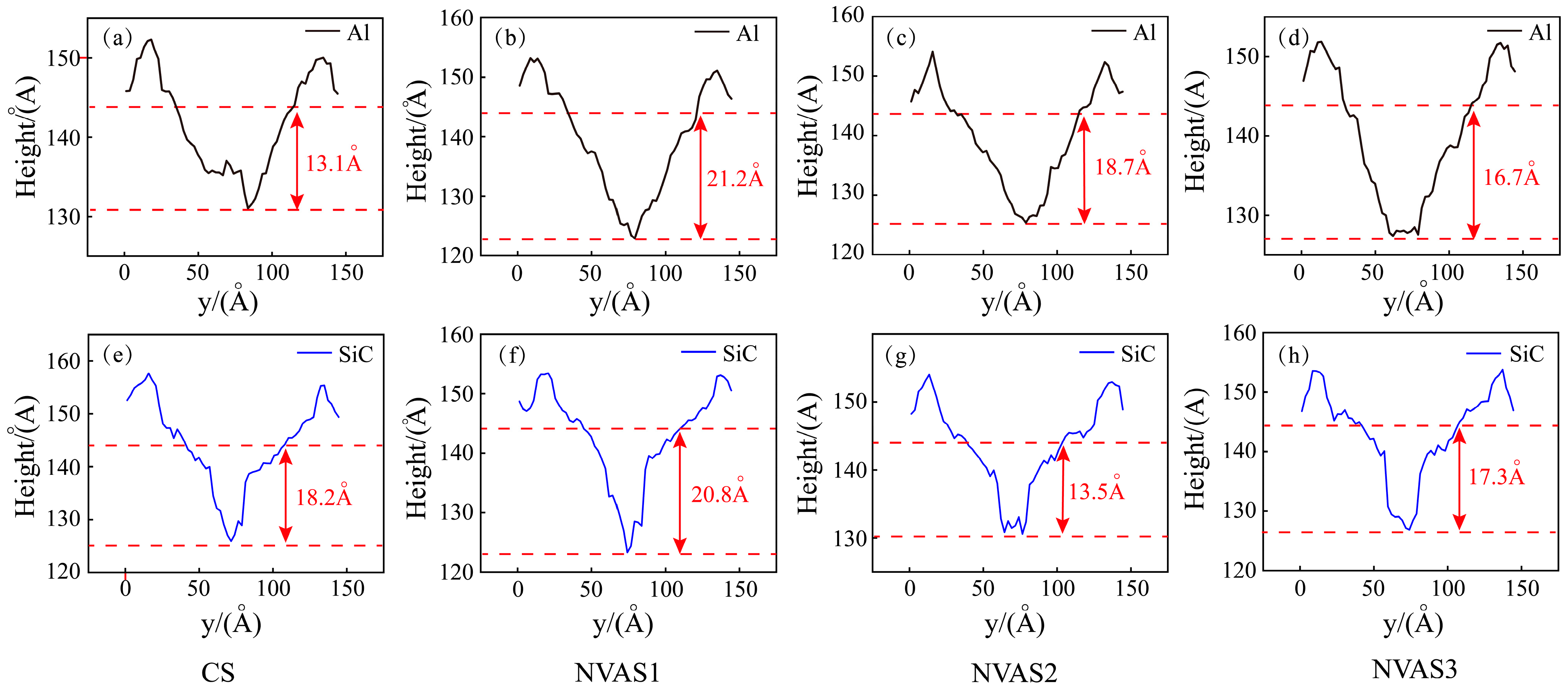
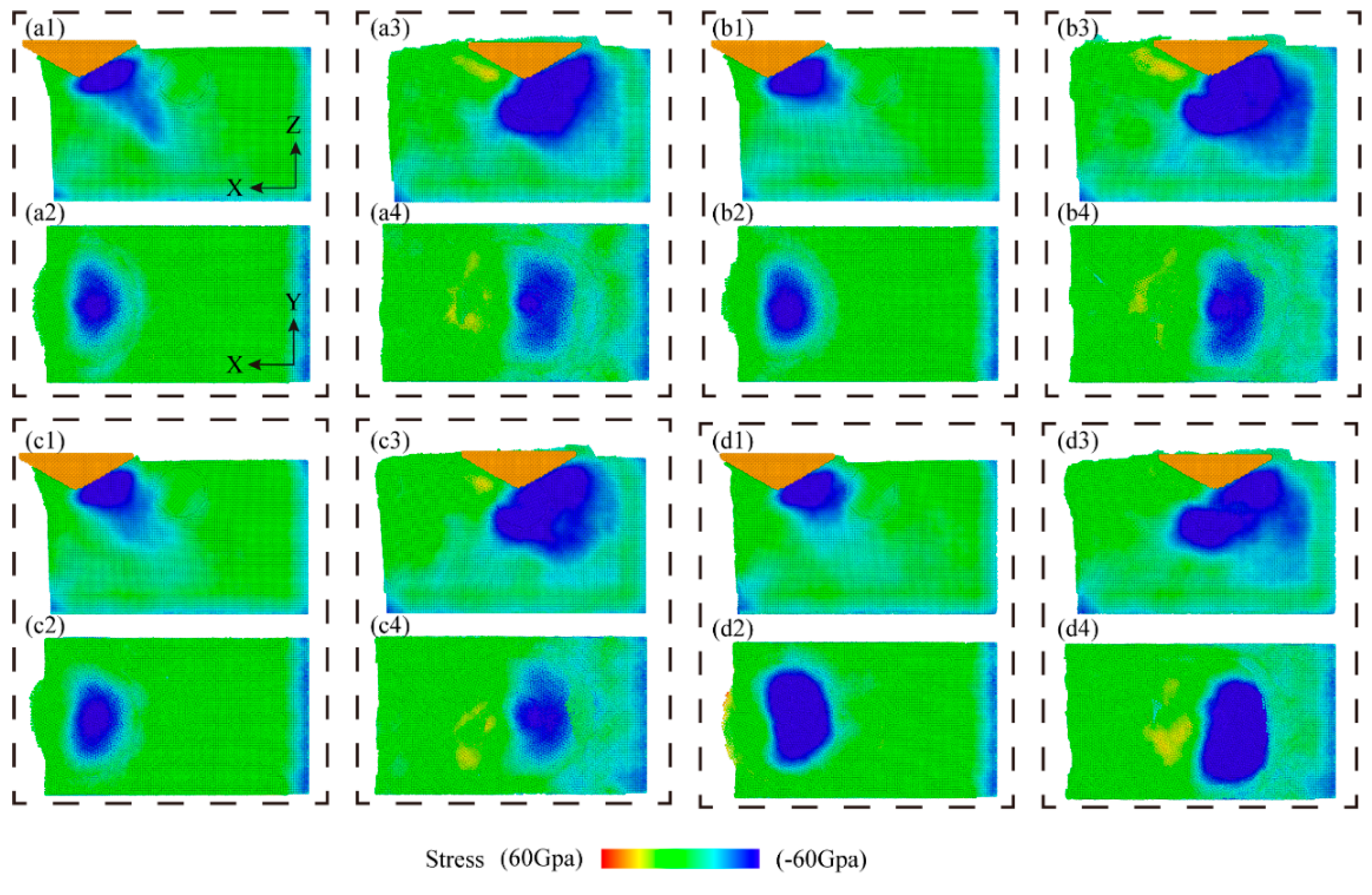


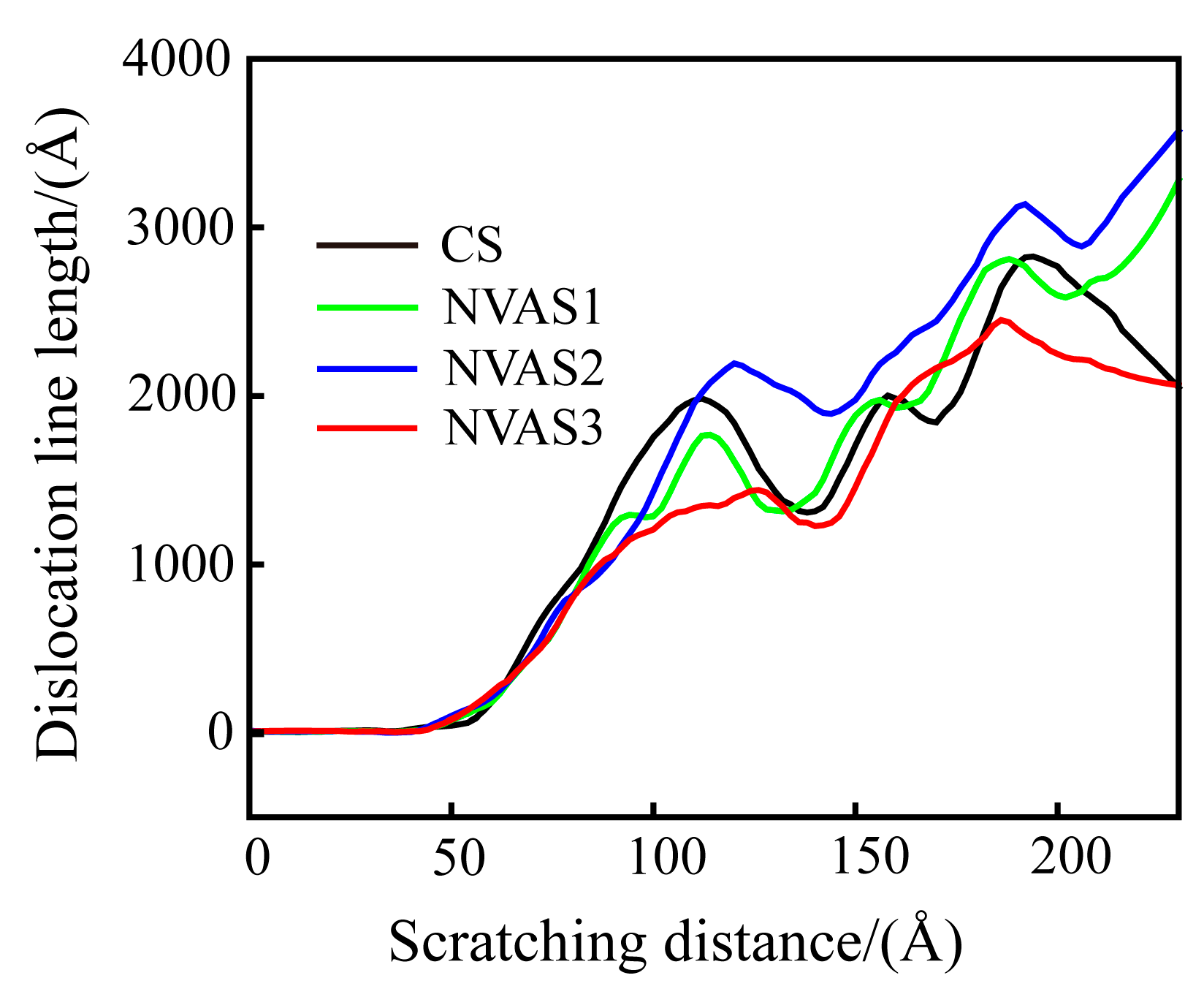
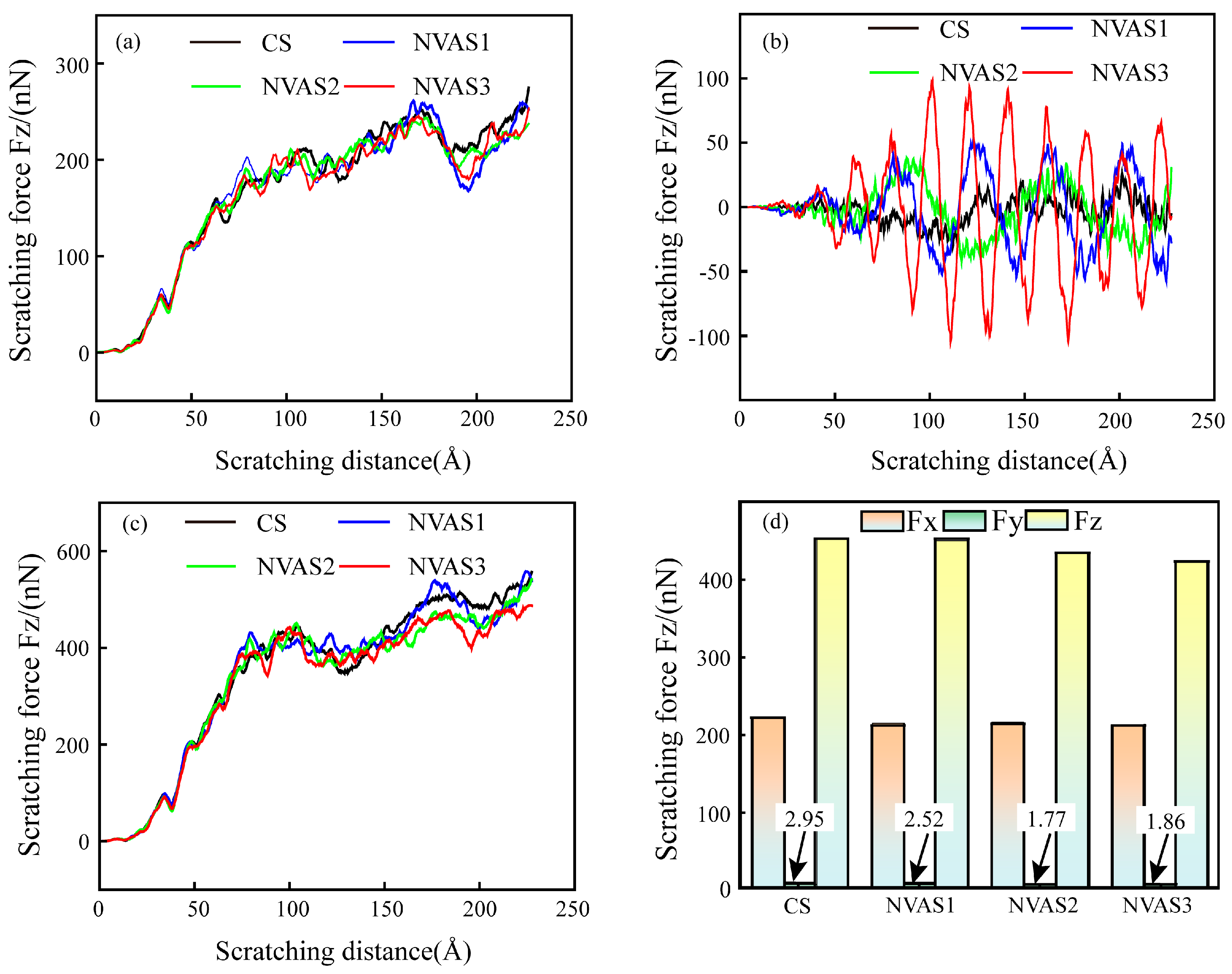
| Number | Scratching Velocity/(μm/s) | Scratching Depth/(μm) | Amplitude/(μm) | Frequency/(Hz) |
|---|---|---|---|---|
| CS1 | 100 | 0.2 | - | - |
| CS2 | 100 | 3 | - | - |
| CS3 | 100 | 6 | - | - |
| NVAS1 | 100 | 0.2 | 5 | 30 |
| NVAS2 | 100 | 0.2 | 5 | 60 |
| NVAS3 | 100 | 0.2 | 5 | 120 |
| Properties | Parameters |
|---|---|
| Atomic number | 318,743 |
| Time step/(ps) | 0.001 |
| Scratching depth/(Å) | 27 |
| Scratching speed/(Å/ps) | 2 |
| Scratching distance/(Å) | 250 |
| Vibration amplitude/(Å) | 3 |
| Vibration frequency/(GHz) | 0, 25, 50, 100 |
| System | Parameters (Unite) | ||
|---|---|---|---|
| (eV) | (Å) | (Å) | |
| 0.004553 | 3.851 | 10.0 | |
| 0.008452 | 4.103 | 10.0 | |
| 0.026342 | 3.48 | 10.0 | |
| 0.026342 | 3.48 | 10.0 | |
| 0.038674 | 3.855 | 10.0 |
Disclaimer/Publisher’s Note: The statements, opinions and data contained in all publications are solely those of the individual author(s) and contributor(s) and not of MDPI and/or the editor(s). MDPI and/or the editor(s) disclaim responsibility for any injury to people or property resulting from any ideas, methods, instructions or products referred to in the content. |
© 2025 by the authors. Licensee MDPI, Basel, Switzerland. This article is an open access article distributed under the terms and conditions of the Creative Commons Attribution (CC BY) license (https://creativecommons.org/licenses/by/4.0/).
Share and Cite
Xi, Y.; Gu, Y.; Lin, J.; Xu, Z.; Fan, Z.; Gao, T.; Zhang, X.; Liu, Y. Study on Material Removal Mechanism of Non-Resonant Vibration-Assisted Scratching High-Volume Fraction SiCp/Al. Micromachines 2025, 16, 360. https://doi.org/10.3390/mi16040360
Xi Y, Gu Y, Lin J, Xu Z, Fan Z, Gao T, Zhang X, Liu Y. Study on Material Removal Mechanism of Non-Resonant Vibration-Assisted Scratching High-Volume Fraction SiCp/Al. Micromachines. 2025; 16(4):360. https://doi.org/10.3390/mi16040360
Chicago/Turabian StyleXi, Yuan, Yan Gu, Jieqiong Lin, Zisu Xu, Zhiduo Fan, Tianyu Gao, Xiaoming Zhang, and Yuanshuo Liu. 2025. "Study on Material Removal Mechanism of Non-Resonant Vibration-Assisted Scratching High-Volume Fraction SiCp/Al" Micromachines 16, no. 4: 360. https://doi.org/10.3390/mi16040360
APA StyleXi, Y., Gu, Y., Lin, J., Xu, Z., Fan, Z., Gao, T., Zhang, X., & Liu, Y. (2025). Study on Material Removal Mechanism of Non-Resonant Vibration-Assisted Scratching High-Volume Fraction SiCp/Al. Micromachines, 16(4), 360. https://doi.org/10.3390/mi16040360







